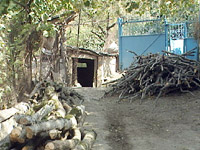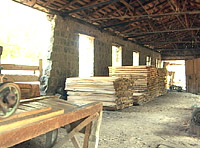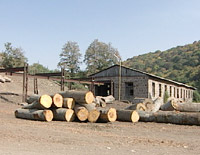
Logging Continues
Forests are Scarce, but Armenia Exports Timber
67-year old Yura Ghiyasyan lives with his wife, Nadia, in their two-story home in the Tavush village of Ditavan. Their two daughters are married in Russia and their son followed them and moved there as well, where he works and supports his parents. Parts of Yura's yard are covered with rows of firewood, seemingly for the winter. But they use the wood throughout the year, not just to heat their house in the cold season.
"We bake our bread in the oven and cook our food on the stove. I have brought this wood with my husband from the forest, loaded on a donkey. We feel sorry for having cut down the trees, but we have no gas - what else could we do? Our village needs gas so that we don't cut down the trees, so that our environment remains beautiful. There are deer in the forest, wild boars; but they are forced to leave when we cut down the trees," said Nadia Ghiyasyan.
Ditavan had been supplied with gas as early as during the Soviet period, in 1967, but the connection ceased in 1992. The village no longer has a network of gas supply lines today. Ditavan is located on the outskirts of a forest and all the villagers bring in wood from there.
"This forest is our lifeline. We bring in wood from there - if we were to have gas, we would not cut the trees down, we would use gas for our needs. Because of a lack of gas, hectares of forest are being destroyed," said Yura Ghiyasyan.
The years of the energy crisis, which began in 1992 and ended in 1996, did not have catastrophic consequences for the Armenian economy alone. Forests faced the brunt of the blow. There was no electricity or gas and people were forced to cut down forests for fuel - there was no choice. Those were the years that Armenia's forest cover reduced drastically. While official figures showed 11 percent of the country to be covered by forests before that, the percentage of forest cover now stands at 7 percent. But the threat to forests did not end then.
In Ditavan, as well as in nearby villages which do not have gas, villagers use the adjacent forest as a source of wood. Although the villagers said that they only bring in dry wood from the forests, one could see green trees cut in their yards as well.
Nobody can blame the villagers for cutting down trees. The forest lies next to the village and the villagers cannot help making use of it. The village communities are poor and cannot finance supplying the village with gas themselves. Armrusgazprom, the company supplying Armenia with gas, cites the distant location of the village and the limited number of customers as its reasons for making investments - supplying such villages with gas is not profitable for the company. Only 33 of the 61 residential locations in the province of Tavush are supplied with gas.
 |
 |
 |
According to Petros Baghmanyan, Deputy Director for Gas Connections and Supply at Armrusgasprom's Tavush branch, said that deforestation had dropped fourfold as a result of new gas connections. He said that the management at Armrusgasprom had proposed collaboration to village heads for new gas connections. That is, if the community were willing to cover a part of the investment required, then the company would cover the rest. However, that is not realistic, because the village communities will not have such finances in the near future. For this reason, many of the village heads have tried to contact benefactors and candidates before parliamentary elections, with the hope that they will be able to raise funds for gas connections to their villages. Some have succeeded in solving the gas problems of their villages through this approach.
In the Tavush village of Acharkut, there is the Sevkar forest management branch office of Armenian Forests, which has a sawmill located next to it. There are logs lying all around the sawmill, waiting to become planks of wood. According to this year's planned decrease by Armenian Forests, 5000 cubic meters of wood would be cut from the forest at the Sevkar branch. According to chief forester Mushegh Madatyan, 70 percent of that would be used as firewood. One cubic meter of firewood costs 8300 drams here, while in the forest a cubic meter of firewood is priced at 4200 drams and thin twigs cost 1200 drams. "The people buy mainly the twigs - most villagers cannot afford the firewood," said Madatyan.
The Sevkar forest management branch has seen the most deforestation in the period from 1992 to 1995. According to official data, 17-20 thousand cubic meters were logged annually. However, those numbers are far from reality. According to environmentalists, 500-700 thousand cubic meters of green forest were cut down in those years.
The 5000 cubic meters planned for logging this year is also unrealistic. According to Mushegh Madatyan, the average villager uses 10-15 cubic meters to heat his home during the winter. If we multiply the number of houses in the village by that number, we get a minimum figure of 1000 cubic meters of used firewood. There are 33 villages without gas in Tavush. Therefore, the minimum amount of firewood used in the province is 33 thousand cubic meters. We must also consider here villages that do have a gas supply, but where many families cannot afford to heat their houses using gas. These families use firewood to heat their homes as well.
If the government is concerned about the fate that awaits these forests, it must make some decisions and take some steps soon. One of them could be a separate gas tariff for vulnerable families in villages lying near forests, where they might pay, for example, half the charge with the government taking the rest of the expense on itself. Unfortunately, awareness about environmental conservation is totally absent in society today. Environmental organizations unite around some issues and make announcements sometimes, but nothing happens afterwards. There are no forces in parliament which are interested in environmental issues or are active in environmental legislation.
Armenia is considered a country with one of the most scarce forest covers in the world, with the figure of 0.12 hectare of per capita forest cover very low in the list. While the official data show 11.2 percent of Armenia's territory to be covered with forests, the figure for Turkey is 14 percent, while in Georgia it is 37.4 percent. The fact that Armenia is a timber exporting country is especially worrying when considered with these figures. The Armenian government has failed, to this day, to tackle one problem -the export of timber, which has now reached enormous proportions.
 Videos
Videos Photos
Photos




Write a comment